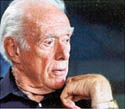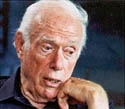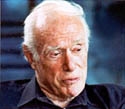|
Issue 2
September 2003

Canadian Pacific
Railway Employee Communications
Room 500 401-9th Ave S.W. Calgary AB
T2P 4Z4
Dreammaker - A chat with
Pierre Berton
By Greg Gormick
Author, newspaperman,
commentator, broadcaster, nationalist, social and environmental advocate, cat fancier
and raconteur. This impressive string of titles fails to do justice to the complete
talents of Pierre Berton. Add to it the remarkable feat of making Canadians read
their history and like it. His status with railroaders is legendary because he's also
the award-winning author of The National Dream and
The Last Spike, the two-volume epic that seared the story
of the building - and the builders - of the CPR into the minds of Canadians. At 83,
he's working on his 50th book, Prisoners of the North. But he recently
took a break to share his memories and his views on railroading, welcoming
Momentum to his home in Kleinburg, Ontario, within earshot of the CPR
transcontinental main line.
 Momentum: When did the railways become part of your life?
Momentum: When did the railways become part of your life?
Berton: I was born in Whitehorse and almost immediately my parents moved to
Dawson City, where my father became mining recorder for the government. So, Dawson is
what I think of as my hometown. The only railway we had was the abandoned Klondike
Mines Railway, which ran up to the height of Bonanza Creek. The engines were in the
park and the tracks were still in place. We kids used to get on the little
hand-pump car and run about five or six miles up and down the line. That
was great fun for us.
 Momentum: When did you first see the CPR?
Momentum: When did you first see the CPR?
Berton: That was when my family went across the country, once at age five and
again at 11. That was 1925 and 1931. We went out on the CPR and came back on the CNR.
They had a radio car where you'd put earphones on and there'd be a guy running it at
the end of the car. I remember listening to the song, The Last Rose of
Summer, but I thought this was pretty boring, so I left.
I remember more about the trip when I was 11. We took the White Pass and Yukon Railway
over the summit from Whitehorse to Skagway. They stopped halfway for lunch, at
Bennett, and told the tourists it was moose meat. I've eaten enough moose meat and I
can tell you it wasn't. The next morning at Skagway, you took the CPR steamship
Princess Louise or Princess Nora and picked up the train at Vancouver.
 Momentum: Did you like train travel as a boy?
Momentum: Did you like train travel as a boy?
Berton: Sure. One thing I've always remembered is that my sister and I saw this
white cord hanging up in the sleeping car, so we swung on it. The next thing I knew,
the train stopped and the conductor put all the passengers off. I figured there must
be some relation between the white cord that I pulled and this train stopping. So, I
didn't say anything to anybody until they got the thing going. But I knew better than
to swing on it a second time.
Momentum: Did you do any travelling during the Second World War, when you
were in army intelligence?
Berton: One year during the war, I crossed Canada 12 times on the CPR. I mostly
remember having to sit up all the time. The trains were packed and the conditions
became somewhat primitive. There was no sleeping car space, except once when I was in
charge of a troop train and I had a compartment to myself. Most of the time it was
just squalling kids and the smell of oranges, But we were drunk all the time anyway,
for God's sake. What the hell else was there to do? I got on a train with my friend,
Jack Bell, and we demolished a bottle between Vancouver and Calgary. Jack said,
"You know Calgary. You were stationed here, so you must know where the liquor
store is. Can you make it from the train in the 10-minute stop?" I
said, "You bet!" So, I did. And we drank the next bottle to Winnipeg,
sitting up in the men's smoking room.
Momentum: When your newspaper career was in full swing, you moved from
Vancouver to Toronto. Did you use the railway much then?
Berton: Yes, because that was 1947 and nobody flew much in those days. When we
went back to Vancouver to say hello, we'd get a bedroom on the train. It was about 15
years before we started using the airplane. And when we moved out of the city to
Kleinburg, this was a stop for the transcontinental trains. When my mother came out,
she'd get off at about seven o'clock in the morning and I'd go down and pick her up
off The Dominion.
Momentum: I understand you arranged to have the Kleinburg station preserved in
the park in town.
Berton: I was having lunch with some CPR friends and they told me that station
wasn't needed and was going to be demolished. I asked if I could have it for the
Scouts and they said, "Sure." I got the CPR to give the Scouts some pictures
and the Morse code key. It was very expensive to move it, though, because we had to
take down the telephone wires and take the roof off and put it back on again.
Kleinburg is a town where everybody comes to get married and the brides always get
photographed in front of the station. Anyway, it's there and I was pleased to be able
to do that.
Momentum: Now we come to The National Dream and The Last Spike.
What led you to write them?
Berton: I had already written several books and had two
Governor-General's Awards, one for Mysterious North and
one for Klondike. I liked Klondike very much because it
deals with large numbers of people moving through time and space.
The building of the railway was like that. That's the kind of history I write. It's
really based on people, not so much as on events. If you can't find some interesting
people, you shouldn't be writing a book. There are some wonderful people in the story
of the CPR and most of them left diaries. It was going to be one volume, but it ended
up as two because I did so much research.
Momentum: Why do you think the books were so successful?
Berton: They came out just three years after Canada's centennial and the
country was going through a great wave of nationalism. Canadians were still ebullient.
And I think the title helped. The National Dream fitted the feeling of
the country at the moment. It was like the American dream. I think it would not have
done as well if it had been published at some other time. It is the
nationalistic book of those I've written and it's different from the others for that
reason. And it did extremely well, to my astonishment. Most times when you do a
two-volume work, the first does much better than the second. Both these
books sold within 100 copies of each other and they sold 130,000 each, which is a
phenomenal sale in this country. I cut them to a paper back and it sold 150,000. I
cut them by one-third for a U.S. edition called The Impossible
Railway. And then I did the picture book, The Great Railway
Illustrated, which also sold well. They were very successful books and people
always mention them.
Momentum: Did the railway welcome the attention you brought to it through
the books?
Berton: The CPR was not very helpful, I must say. They wouldn't give me access
to many of the documents they had. There were no secrets, but I guess they thought
there were. [ At the time, CPR had no archives policy and no real idea of the
extent of its historic papers from the construction era: Ed. ]
But I will say one thing for the CPR: Buck Crump was very good. He was chairman
at that time and he arranged for me to travel the country on a business car and get
off at every divisional point, where CPR personnel would tell me about the mechanical
and physical problems of building the railway in that spot. That was very useful. And
then I ran into Alex Price, who worked for the CPR and was also an amateur historian
in Calgary, and he was very good. I did a lot of work with him.
Momentum: You wrote that the general manager, W.C. Van Horne, was the most
fascinating immigrant ever to come to Canada.
Berton: By far. He was a broad-gauge man who did everything,
including geology and magic tricks! They even named a couple of trilobites after him.
And he was called the ablest railway general in the world. An American who came here
from the Milwaukee Road, build the CPR and became a fervent nationalist.
Momentum: You've often said the CPR is one of the things that makes Canada
different from other countries.
Berton: It tied the country together from west to east because there was
nothing in the centre to hold it. To get British Columbia in, they had to make a
promise of a transportation route and that's why the CPR was built. Even today, the
country is shaped like a railway from a population point of view. It's physically
square, but there are no people 200 miles from the tracks. We're a country like
Chile: 4,000 miles long and 100 or 200 miles thick. The United States is a
square country and it makes them think differently. We think east-to-west
all the time.
What also makes us different is the fact that our definitive moment is not a
revolution or a civil war. It's the building of the railway. It's
non-violent. The battle is with nature and topography and climate. That's
so Canadian.
Momentum: The success of the two books led to the eight-part
Canadian Broadcasting Corporation television series.
Berton: That, of course, helped the books tremendously. We worked on it for
about two years and went all over the country. We shot the building of the Fraser
River section on the old Kettle Valley Railway. It was partly dismantled, which was
great. Because if you partly dismantle a bridge, you don't know if it's going down or
up. A lot of that stuff that pretends to be the construction is actually the
destruction. We went all over the country looking for locations. We decided Brooks,
Alberta, was the place to do the prairie construction sequences. We had a track gang
working with us: half actors, half real CPR tracklayers. It worked out very
well and sold all over the world. The Arabs, for God's sake, bought it for a huge sum
of money. It was everywhere. I just got a royalty cheque today for $30.
Momentum: We've been talking about railway history, but you told me earlier
that you feel the railways have a bright future.
Berton: We're going to have a problem with oil and gasoline. The prices are
going too high and it's a diminishing resource. The time is going to come when it's
much more economical to transport people and goods by rail than by any other method.
It's much cheaper, simpler and kinder to our environment. Certainly for freight,
trains are already very important. But short intercity passenger and commuter services
will become more important. We already have the GO commuter trains here in Toronto and
there will have to be more of those. There's really no choice. The highways are
getting clogged.
Momentum: I hear you bought a sort of railway of your own.
Berton: We've got a CPR wooden caboose, but I didn't buy it. The kids got it
from the CPR for me, but it was the most expensive present I've ever had. We had to
hire a double crane and tracklayers to build some track for it. My wife, Janet, said,
" Let's have bigger windows so we can enjoy the view." We found out the
cars have a steel superstructure under the wood and it was a hell of a job enlarging
the windows. But we use it a lot. It's still got a pot-bellied stove.
And we don't have to pay tax on it because it's on rails and that means it's mobile,
not a permanent building.
Momentum: Living and working so close to the CPR, do you hear the trains
whistling for the crossings?
Berton: Yes, I do. I like the sound of the trains. But I like the old steam
whistle better than I do the diesel, you know.
Momentum: Thanks for sharing your railway memories with the employees of the
CPR.
Berton: Not at all. Glad to do it. Come on and I'll show you our caboose.
©
2005 William C. Slim
http://www.okthepk.ca
|